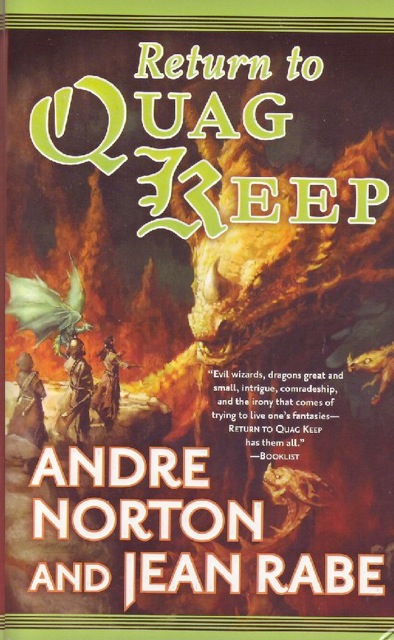For the most part I’ve been reading and rereading Andre Norton’s solo novels. She wrote so many, and there are still quite a few left to go. Once in a while however I’ll pick up one of her collaborations, to round out a series or to satisfy my curiosity about what she intended to happen next.
Quag Keep has a typical abrupt Norton closing, and it’s typically open-ended as well. The adventure is finished but the adventurers from our world are still trapped in the world of the game. There are clear pointers toward a sequel, but Norton never got around to finishing it.
Jean Rabe’s posthumous collaboration answers quite a few of my questions about What Next.
It also has much more to say about who the gamers are (or were) in our world, and fills in the background of most of them, at least to the extent of telling us where on Earth they came from. There’s even a second group, though all but one of those are killed off before we meet them.
The basic outline of the plot has a Norton feel to it. Our heroes and our token heroine are trying to scrape a living in the world of the game, and not doing very well at it. There’s someone or something that wants to kill them, and pursues them when most of them are hired as guards for a merchant caravan. There’s also a wizard in a dungeon, a Big Nasty that (as a very peripheral D&D-er) I think is based on a Black Pudding? and a return to Quag Keep, where the adventure finally reaches a conclusion.
Some things that Rabe contributed are quite nice. She describes settings and outfits and weapons in detail. She treats horses as living animals rather than machines, and there’s one particular magical mare that I would have loved to see more of. Her characters have a much more obvious inner life than Norton’s versions, reflect often and at length on their lives on Earth and whether and how, or for that matter if, they can return home.
A few things I like quite a bit. I particularly like the idea that Earth has been drained of magic, but there are still areas in which magic persists, including spots in Australia, Florida, and Wisconsin. The image of the blue and green Earth with golden flecks of magic is lovely.
I wanted to like this book much more than I did. It gave me things I was looking for and didn’t get in the prequel, notably the details about the characters’ lives on Earth. Some of the description is really nice, and it’s clear Rabe put a lot of thought into the minutiae of the world. She takes the time and trouble to give us detailed backdrops for her scenes, and she puts evident effort into inhabiting the personalities of multiple characters in addition to Norton’s original and sole viewpoint, Milo the Swordsman.
One thing Norton was really good at was plotting. Her novels in general are heavily plot-driven, and those plots can sometimes be rather episodic, but her pacing is deft and usually spot on. Her stories move rapidly and the line of the plot for the most part is clear. She seldom rambles or loses track of what she’s doing, and she doesn’t often drop threads or characters.
Rabe’s plotting is much less skillful. Rather than keeping her group of adventurers together, she sends the lizard man and the Druid (with his very useful healing spells) out of the story altogether, not to be seen again until a brief, tacked-on scene at the very end of the Epilogue. The rest go off together, except for one who stays behind to pay a debt run up by two others; all too soon it becomes clear he is a Sacrificial Plot Bunny, put in place to be killed off for Plot Reasons.
Buy the Book


Upright Women Wanted
Later, when the group with the caravan breaks up, there’s much outcry about Not Breaking Up The Group, despite the fact that it has already been broken up twice without any such drama. The plot is in control here, and not in a convincing way.
The pacing lacks Norton’s skill, as well. Rabe’s long descriptions and frequent digressions, combined with her characters’ lengthy reflections on their lives on Earth, show up even in the middle of battle scenes, slowing them down and sometimes grinding them to a halt. She inserts a long and irrelevant chapter from an elven romance novel into a fraught sequence in which a small subset of the characters are hiding out in Quag Keep (but somehow managing to be completely undetected by the huge, noisy giant-troll guards). It does not help that she tends to repeat the same information in the same words, over and over, scene after scene, chapter after chapter.
I caught myself early on flipping over into editor mode, and I kept having to force myself back to reading as a reader. There are quite a few copyediting slippages, and some major continuity failures. The mini-dragon’s name in Quag Keep is Afreeta, but here she’s Alfreeta. Milo’s thumb rings are a major plot element in the prequel: the one with the red dots and lines is a map, and the one with the cloudy stone turns out to reveal the truth of illusions. But in the sequel he has no idea what they are or what they do, and when he does finally figure out how to use them, they don’t do anything like what they did in the first volume of the series.
I wish that this novel had had the services of a good and attentive editor. Not just to sort out the continuity, but to smooth out the plotting, speed up the pacing, trim the many repetitions, and rethink the way in which she used the characters—keeping them all together at the start, and streamlining their movements once they got going toward the end.
That end begs for another sequel, too. Leaving aside the characters who were dumped or killed off, there’s still a core of hunky guys and one sexy token girl, plus a skinny little thief who used to be a hunk. And here they are back on Earth in full fantasy fig, weapons and all. What happens next? Where do they go, what do they do, and what actually became of their mundane alter egos? Will we ever know?
In the meantime, I’m headed back to the dawn of Norton’s writing career, to one of her very first published novels, Ralestone Luck. That should be interesting.
Judith Tarr’s first novel, The Isle of Glass, appeared in 1985. Her most recent novel, Dragons in the Earth, a contemporary fantasy set in Arizona, was published by Book View Cafe. In between, she’s written historicals and historical fantasies and epic fantasies and space operas, some of which have been published as ebooks from Book View Café and Canelo Press. She has won the Crawford Award, and been a finalist for the World Fantasy Award and the Locus Award. She lives in Arizona with an assortment of cats, a blue-eyed dog, and a herd of Lipizzan horses.










